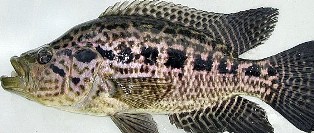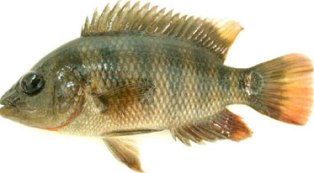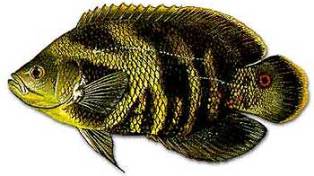Discover Florida Nature
It's time to explore the natural Florida


|
|
|
|
|
 Jaguar
Guapote (Cichlasoma managuense) A broken lateral line
and black-and-white patterning make the jaguar guapote distinct. It has
a toothed and protrusible mouth, and numerous purple to black spots or
blotches on it's body and fins with a series of black squares along
their side. male jaguar guapote are typically larger than females. The
only local species that might be confused with the jaguar guapote is the
black crappie, but guapote's teeth and broken lateral line instantly set
it apart. Known mostly from coastal canal systems of southeast Florida,
ranging as far north as West Palm Beach, the jaguar guapote was first
reported in Florida in 1992 from a photograph of two specimens caught in
a farm pond, near Miami Canal, and is currently found in southeast
Florida box-cut canals The jaguar guapote has a native range in the
Atlantic slope of Central and South America. Tolerant of poor water
quality, in it's native range the jaguar guapote occupy a variety of
habitats including rivers and lakes with muddy, sandy, and rocky
bottoms. A medium-sized opportunistic predator; jaguar guapote feeds
primarily on small fish (including many exotic species) and aquatic
insects, it also consumes some snails, worms, and even an occasional
lizard. The largest jaguar guapote collected by FWC was about 16 inches
long and weighed 2.8 pounds, but they reportedly grows larger. Most
spawning occurs from March through July, with a secondary peak in
October-November. Jaguar
Guapote (Cichlasoma managuense) A broken lateral line
and black-and-white patterning make the jaguar guapote distinct. It has
a toothed and protrusible mouth, and numerous purple to black spots or
blotches on it's body and fins with a series of black squares along
their side. male jaguar guapote are typically larger than females. The
only local species that might be confused with the jaguar guapote is the
black crappie, but guapote's teeth and broken lateral line instantly set
it apart. Known mostly from coastal canal systems of southeast Florida,
ranging as far north as West Palm Beach, the jaguar guapote was first
reported in Florida in 1992 from a photograph of two specimens caught in
a farm pond, near Miami Canal, and is currently found in southeast
Florida box-cut canals The jaguar guapote has a native range in the
Atlantic slope of Central and South America. Tolerant of poor water
quality, in it's native range the jaguar guapote occupy a variety of
habitats including rivers and lakes with muddy, sandy, and rocky
bottoms. A medium-sized opportunistic predator; jaguar guapote feeds
primarily on small fish (including many exotic species) and aquatic
insects, it also consumes some snails, worms, and even an occasional
lizard. The largest jaguar guapote collected by FWC was about 16 inches
long and weighed 2.8 pounds, but they reportedly grows larger. Most
spawning occurs from March through July, with a secondary peak in
October-November. Mayan
Cichlid
(Cichlasoma urophthalmus) First recorded in Florida
Bay in 1983, the Mayan cichlid is now established and abundant in south
Florida as far north as Lake Okeechobee and the St. Lucie Canal. The
Mayan cichlid is native to Atlantic slope of Central and South America.
Like so many members of the family Cichlidae, the Mayan cichlid thrives
under a wide range of environmental conditions. Within their native
range this euryhaline fish is found in a wide range of coastal lowland
habitats, exhibiting a tolerance if not outright affinity for brackish
to marine conditions. Mayan cichlids have even been observed to breed in
the sandy areas near coral reefs. The Mayan cichlid has a classical fish
shape. Like many cichlids it bears a more than superficial resemblance
to the North American sunfishes of the family Centrarchidae. The body is
ovate and the first dorsal and anal fin are spinous. The caudal fin is
slightly rounded. The pectoral and pelvic fins are unremarkable in size
and color. The mouth is neither large nor small and is in proportion
with the body. The most distinctive feature of the Mayan cichlid is its
coloration. The Mayan cichlid is a predator of small fishes and aquatic
invertebrates. Plant matter and detritus have been recorded from the
stomachs of Mayan cichlids although it is likely that these items are
ingested incidentally to the consumption of a primary prey. Mayan
Cichlid
(Cichlasoma urophthalmus) First recorded in Florida
Bay in 1983, the Mayan cichlid is now established and abundant in south
Florida as far north as Lake Okeechobee and the St. Lucie Canal. The
Mayan cichlid is native to Atlantic slope of Central and South America.
Like so many members of the family Cichlidae, the Mayan cichlid thrives
under a wide range of environmental conditions. Within their native
range this euryhaline fish is found in a wide range of coastal lowland
habitats, exhibiting a tolerance if not outright affinity for brackish
to marine conditions. Mayan cichlids have even been observed to breed in
the sandy areas near coral reefs. The Mayan cichlid has a classical fish
shape. Like many cichlids it bears a more than superficial resemblance
to the North American sunfishes of the family Centrarchidae. The body is
ovate and the first dorsal and anal fin are spinous. The caudal fin is
slightly rounded. The pectoral and pelvic fins are unremarkable in size
and color. The mouth is neither large nor small and is in proportion
with the body. The most distinctive feature of the Mayan cichlid is its
coloration. The Mayan cichlid is a predator of small fishes and aquatic
invertebrates. Plant matter and detritus have been recorded from the
stomachs of Mayan cichlids although it is likely that these items are
ingested incidentally to the consumption of a primary prey. Oscar
(Astronotus ocellatus) Young oscars have wavy white
and orange markings on black background, while the body and fins of
adults have olive blue-green and mustard colors, highlighting large dark
blotches, and a bright red eyespot at base of upper caudal fin. The
oscar's body is a stout more oval body shape than native bream, some
have orange or red markings and all have a thick mucus coat on the body.
Oscars are most abundant in canals of water conservation areas and the
Everglades habitats of Collier,
western Miami-Dade, Broward, and Palm Beach counties. Oscar fish occur
throughout south Florida, but are typically not as abundant as in
marsh-related canals, where they are most successful in canals running
through marsh habitats. Oscar are found in lesser numbers in coastal
canals, ponds, and lakes from central Florida southward. Native range of
the oscar fish includes the Orinoco, La Plata, and Amazon river basins
in South America, where they feed primarily on small fish, insects, and
crustaceans. Two-pound oscars are considered large. The IGFA record for
an oscar caught in Florida was an exceptional fish reported to weigh 3.5
pounds. Oscars caught in the Everglades average 10 inches and twelve
ounces; biologists do not know how long oscars typically live. Oscar
(Astronotus ocellatus) Young oscars have wavy white
and orange markings on black background, while the body and fins of
adults have olive blue-green and mustard colors, highlighting large dark
blotches, and a bright red eyespot at base of upper caudal fin. The
oscar's body is a stout more oval body shape than native bream, some
have orange or red markings and all have a thick mucus coat on the body.
Oscars are most abundant in canals of water conservation areas and the
Everglades habitats of Collier,
western Miami-Dade, Broward, and Palm Beach counties. Oscar fish occur
throughout south Florida, but are typically not as abundant as in
marsh-related canals, where they are most successful in canals running
through marsh habitats. Oscar are found in lesser numbers in coastal
canals, ponds, and lakes from central Florida southward. Native range of
the oscar fish includes the Orinoco, La Plata, and Amazon river basins
in South America, where they feed primarily on small fish, insects, and
crustaceans. Two-pound oscars are considered large. The IGFA record for
an oscar caught in Florida was an exceptional fish reported to weigh 3.5
pounds. Oscars caught in the Everglades average 10 inches and twelve
ounces; biologists do not know how long oscars typically live.
|
|
|
Advertise | Privacy Statement | Dog Encyclopedia | Video |Contact | Alaska Nature |
|